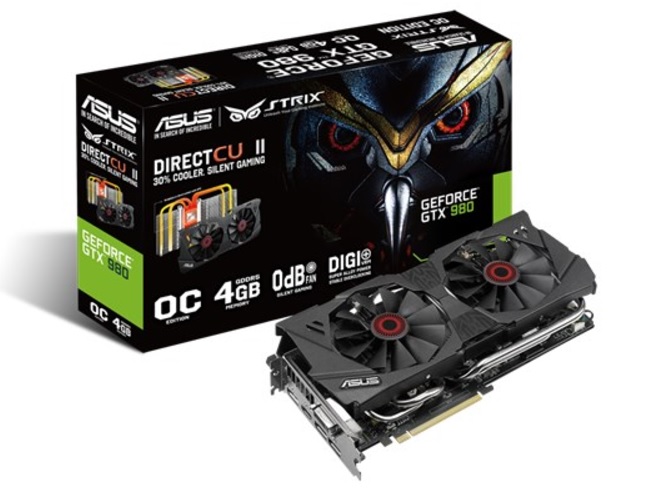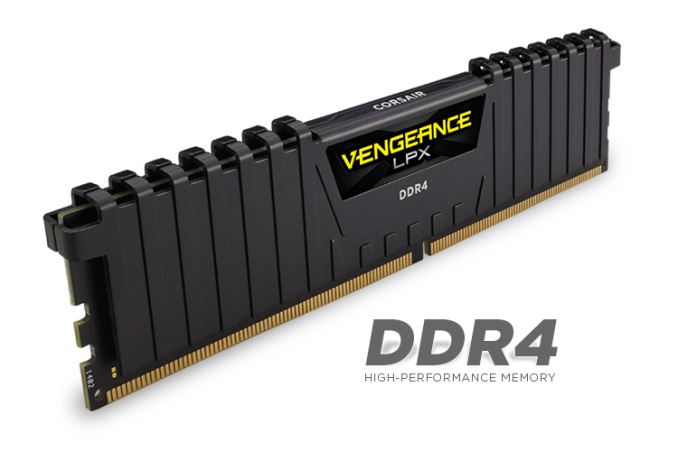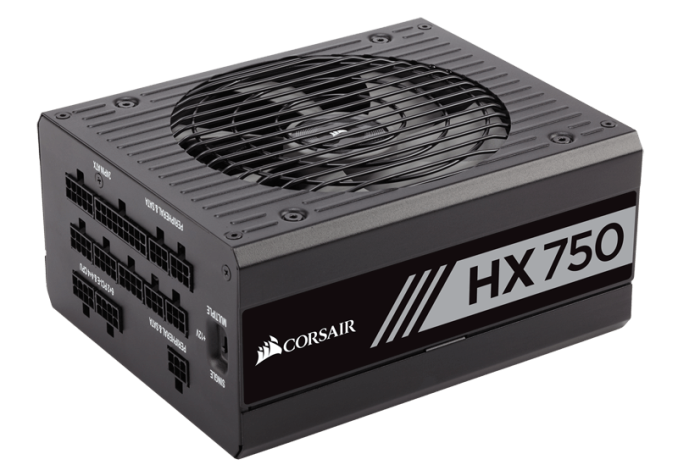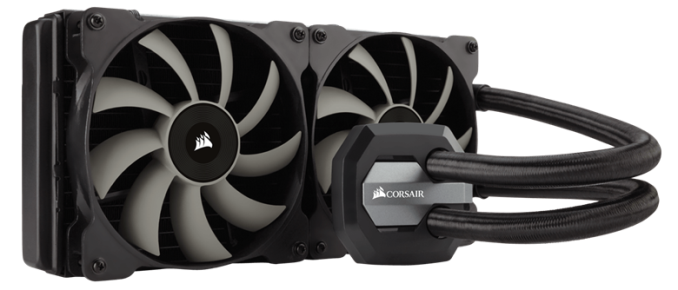The MSI X299 Gaming M7 ACK Motherboard Review: Light up the Night
by Joe Shields on March 5, 2018 10:00 AM EST- Posted in
- Motherboards
- MSI
- ATX
- M.2
- USB 3.1
- RGB
- X299
- Basin Falls
- Skylake-X
- Kaby Lake-X
- i9-7900X
Board Features
The MSI X299 Gaming M7 ACK is a high-end board from MSI sitting right up there with the flagship X299 XPower Gaming AC. The high-end board updates MSI's M.2 heatsinks with a more formidable cooling solution, dubbed M.2 Shield Frozr, which is attached to the chipset heatsink via a hinge. This is a unique implementation for such a board.
The board includes a bunch of RGB LEDs in multiple zones for lighting. It also uses dual Realtek ALC1220 codecs, one for the front panel and one for the rear, with Audio Boost 4 Pro parts. Networking comes from the Killer E2500 NIC for wired, and the Killer AC1535 for Wi-Fi. On the storage front there are eight SATA ports, two M.2 slots, as well as a U.2 port while on the USB side of things, support for both back panel USB 3.1 (10 Gbps) and front panel is included. Driving the CPU is a 10-phase VRM with robust Infineon(IR) power bits. Overall, quite a feature-laden board.
| MSI X299 Gaming M7 ACK | |
| Warranty Period | 3 Years |
| Product Page | Link |
| Price | $366 (Amazon) |
| Size | ATX |
| CPU Interface | LGA2066 |
| Chipset | Intel X299 |
| Memory Slots (DDR4) | Eight DDR4 Quad Channel Supporting 128GB Up to DDR4-4266 |
| Network Connectivity | 1 x Killer E2500 LAN 1 x Killer AC1535 802.11ac |
| Onboard Audio | Dual Realtek ALC1220 |
| PCIe Slots for Graphics (from CPU) | 4 x PCIe 3.0 - 44 Lane CPU: x16/x4/x16/x8 - 28 Lane CPU: x16/x4/x8/x0 or x8/x4/x8/x8 - 16 Lane CPU: x8/x0/x8/x0 or x8/x4/x4/x0 |
| PCIe Slots for Other | 2 x PCIe 3.0 x1 |
| Onboard SATA | 8 x RAID 0/1/5/10 |
| Onboard SATA Express | None |
| Onboard M.2 | 2 x PCIe 3.0 x4 and SATA modes |
| Onboard U.2 | 1 x PCIe 3.0 x4 |
| USB 3.1 | ASMedia ASM3142 1 x Type-A Port (back panel) 1 x Type-C Port (back panel) 1 x Internal Header |
| USB 3.0 | ASMedia ASM1074 3 x Type-A (back panel) Chipset 1 x Type-A (back panel) 2 x Internal Headers |
| USB 2.0 | Chipset 3 x Type-A (back Panel) 2 x Internal Headers |
| Power Connectors | 1 x 24-pin ATX 1 x 8-pin CPU 1 x 4-pin CPU (optional) |
| Fan Headers | 1 x 4-pin CPU 1 x 4-pin Water Pump 4 x 4-pin System Fans |
| IO Panel | 1 x Clear CMOS 1 x BIOS Flashback+ button 1 x PS/2 Keyboard/mouse combo port 3 x USB 2.0 ports 2 x Wi-Fi Antenna connectors 4 x USB 3.1 (5 Gbps) ports 1 x LAN (RJ45) ports 1 x USB 3.1 (10 Gbps) Type-A port 1 x USB 3.1 (10 Gbps) Type-C port 1 x Optical S/PDIF OUT connector 5 x OFC audio jacks |
Test Bed
As per our testing policy, we take a high-end CPU suitable for the motherboard that was released during the socket’s initial launch and equip the system with a suitable amount of memory running at the processor maximum supported frequency. This is also typically run at JEDEC sub timings where possible. It is noted that some users are not keen on this policy, stating that sometimes the maximum supported frequency is quite low, or faster memory is available at a similar price, or that the JEDEC speeds can be prohibitive for performance. While these comments make sense, ultimately very few users apply memory profiles (either XMP or other) as they require interaction with the BIOS, and most users will fall back on JEDEC supported speeds - this includes home users as well as industry who might want to shave off a cent or two from the cost or stay within the margins set by the manufacturer. Where possible, we will extend our testing to include faster memory modules either at the same time as the review or a later date.
Readers of our motherboard review section will have noted the trend in modern motherboards to implement a form of MultiCore Enhancement / Acceleration / Turbo (read our report here) on their motherboards. This does several things, including better benchmark results at stock settings (not entirely needed if overclocking is an end-user goal) at the expense of heat and temperature. It also gives, in essence, an automatic overclock which may be against what the user wants. Our testing methodology is ‘out-of-the-box’, with the latest public BIOS installed and XMP enabled, and thus subject to the whims of this feature. It is ultimately up to the motherboard manufacturer to take this risk – and manufacturers taking risks in the setup is something they do on every product (think C-state settings, USB priority, DPC Latency/monitoring priority, overriding memory sub-timings at JEDEC). Processor speed change is part of that risk, and ultimately if no overclocking is planned, some motherboards will affect how fast that shiny new processor goes and can be an important factor in the system build.
| Test Setup | |
| Processor | Intel i9 7900X (10C/20T, 3.3G, 140W) |
| Motherboard | MSI X299M Gaming M7 ACK (BIOS v1.60) |
| Cooling | Corsair H115i |
| Power Supply | Corsair HX750 |
| Memory | Corsair Vengeance LPX 4x8GB DDR4 2666 CL16 Corsair Vengeance 4x4GB DDR4 3200 CL16 |
| Memory Settings | DDR4 2666 CL16-18-18-35 2T |
| Video Cards | ASUS Strix GTX 980 |
| Hard Drive | Crucial MX300 1TB |
| Optical Drive | TSST TS-H653G |
| Case | Open Test Bed |
| Operating System | Windows 10 Pro 64-bit |
Many thanks to...
We must thank the following companies for kindly providing hardware for our multiple test beds. Some of this hardware is not in this testbed specifically but is used in other testing.
Thank you to ASUS for providing us with GTX 980 Strix GPUs. At the time of release, the STRIX brand from ASUS was aimed at silent running, or to use the marketing term: '0dB Silent Gaming'. This enables the card to disable the fans when the GPU is dealing with low loads well within temperature specifications. These cards equip the GTX 980 silicon with ASUS' Direct CU II cooler and 10-phase digital VRMs, aimed at high-efficiency conversion. Along with the card, ASUS bundles GPU Tweak software for overclocking and streaming assistance.
The GTX 980 uses NVIDIA's GM204 silicon die, built upon their Maxwell architecture. This die is 5.2 billion transistors for a die size of 298 mm2, built on TMSC's 28nm process. A GTX 980 uses the full GM204 core, with 2048 CUDA Cores and 64 ROPs with a 256-bit memory bus to GDDR5. The official power rating for the GTX 980 is 165W.
The ASUS GTX 980 Strix 4GB (or the full name of STRIX-GTX980-DC2OC-4GD5) runs a reasonable overclock over a reference GTX 980 card, with frequencies in the range of 1178-1279 MHz. The memory runs at stock, in this case, 7010 MHz. Video outputs include three DisplayPort connectors, one HDMI 2.0 connector, and a DVI-I.
Further Reading: AnandTech's NVIDIA GTX 980 Review
Thank you to Crucial for providing us with MX300 SSDs. Crucial stepped up to the plate as our benchmark list grows larger with newer benchmarks and titles, and the 1TB MX300 units are strong performers. Based on Marvell's 88SS1074 controller and using Micron's 384Gbit 32-layer 3D TLC NAND, these are 7mm high, 2.5-inch drives rated for 92K random read IOPS and 530/510 MB/s sequential read and write speeds.
The 1TB models we are using here support TCG Opal 2.0 and IEEE-1667 (eDrive) encryption and have a 360TB rated endurance with a three-year warranty.
Further Reading: AnandTech's Crucial MX300 (750 GB) Review
Thank you to Corsair for providing us with Vengeance LPX DDR4 Memory, HX750 Power Supply, and H115i CPU Cooler.
Corsair kindly sent a 4x8GB DDR4 2666 set of their Vengeance LPX low profile, high-performance memory for our stock testing. The heatsink is made of pure aluminum to help remove heat from the sticks and has an eight-layer PCB. The heatsink is a low profile design to help fit in spaces where there may not be room for a tall heat spreader; think a SFF case or using a large heatsink. Timings on this specific set come in at 16-18-18-35. The Vengeance LPX line supports XMP 2.0 profiles for easily setting the speed and timings. It also comes with a limited lifetime warranty.
Powering the test system is Corsair's HX750 Power Supply. This HX750 is a dual mode unit able to switch from a single 12V rail (62.5A/750W) to a five rail CPU (40A max ea.) and is also fully modular. It has a typical selection of connectors, including dual EPS 4+4 pin four PCIe connectors and a whopping 16 SATA power leads, as well as four 4-pin Molex connectors.
The 135mm fluid dynamic bearing fan remains off until it is 40% loaded offering complete silence in light workloads. The HX750 comes with a ten-year warranty.
In order to cool these high-TDP HEDT CPUs, Corsair sent over its latest and largest AIO in the H115i. This closed-loop system uses a 280mm radiator with 2x140mm SP140L PWM controlled fans. The pump/block combination mounts to all modern CPU sockets. Users are also able to integrate this cooler into the Corsair link software via USB for more control and options.















32 Comments
View All Comments
mkaibear - Monday, March 5, 2018 - link
>dual Realtek audio chipsHrm
>Killer based networking,
Pass
> and plenty of RGB LEDs to light up the case
Hard pass
CheapSushi - Monday, March 5, 2018 - link
Hating on Killer NICs has become a dumb meme. And guess what? The newer chips are often actual Intel. https://www.anandtech.com/show/12178/its-actually-...mkaibear - Monday, March 5, 2018 - link
I choose to "hate on them" because their USP is that they make the board somehow faster in online gaming, yet every independent test shows them to not do that - plus they increase the BOM significantly for no real benefit.The Killer chips on this board aren't Intel btw.
(There's a bit of personal history involved too - I've had several machines with Killer networking chips and they've all had significant driver problems)
nevcairiel - Tuesday, March 6, 2018 - link
Reputation is hard to fix, and if its just an Intel chip, whats the premium you get from those exactly?Personally I'll always prefer a board with plain Intel NICs, and WiFi on a PC board is meaningless to me anyway (the one you linked is Killer WiFi, not Ethernet)
Flunk - Tuesday, March 6, 2018 - link
Still a waste of money on that BoM and you get the annoying Killer app.Something being mentioned in a meme (and all memes are dumb), doesn't make it untrue.
Pork@III - Monday, March 5, 2018 - link
RGB LED give you +20 armor :D69369369 - Monday, March 5, 2018 - link
RGB LED give me erection :DPeachNCream - Monday, March 5, 2018 - link
Yet another x299 motherboard review of yet another yawn-fest RGB and Killer NIC been there and done that also ran gaming product. What's missing here is a non-standard approach and reviews up and down the product stacks of various vendors. This is what happens when you rely exclusively on what companies are willing to send you for free in the mail. They spoon feed journalists a series of gaming-class products with stupid features so we readers rarely see any decent analysis on the wider cost ranges of boards out there because poor people like Joe end up wasting their time messing with boards that only a small number of people purchase. The same thing happens with phones, processors, GPUs, and so forth.I'm sorry if this sounds rude, but it's frustrating and makes this Peach not overly fond of tech journalism at large. Add that to the years of touting Rivet Networks Killer products without ever justifying it with a benchmark or two that demonstrates there's a reason for the boosting writers have to do and it the whole site feels disappointing even if there's value in other articles. I mean there's not even a networking benchmark at all so we can't even infer added value by comparing a Killer whatever to vanilla Intel using results elsewhere. If the opening shots of the article are going to cite networking connectivity, why isn't that given even a cursory examination in the subsequent pages? What's going on Anandtech?
Ian Cutress - Monday, March 5, 2018 - link
Networking is extremely hard to get right as a test. It's easy to run it at peak speeds, but networks are rarely used in that instance.As for the marked benefit of Killer, it comes down to something not overly benchmarkable: online performance with concurrent data streams. If you are gaming, plus downloading, plus streaming, plus watching youtube on another monitor etc, the priority thing does its job. Most solutions are purely software-based - Killer's stuff is actually in hardware: for what isn't whitelisted, the packet analytics can work to decipher what sort of data is coming through, and from where: video, audio, direct downloads, torrents, and such all have detectable ways that the packet data is processed. Different codecs can have different packet profiles, and the Killer stuff is designed to detect them and adjust the return priority as appropriate. A packet will get tagged with a priority and sit in the incoming/outgoing queues, sometimes bypassing the queue altogether. Without deep networking knowledge, and hooks into the Killer hardware requirements, this is super difficult to benchmark. Unless you want a non-repeatable test with an uninterpretable result, or a repeatable test with no real-world value.
I'd love to get some proper Killer testing in, combined with an interview with the CEO and CTO. I can just tell from the comments that it would be a piece that people come just to comment negatively, rather than read, because of the Killer experience in the past. It's a topic I've discussed with the Killer team on numerous occasions.
As for the glut of X299 reviews, we have different reviewers for each chipset/socket: Joe on X299/Z370, Gavin on AM4, Tracy on TR4. Tracy has been waylayed due to lack of hardware, Gavin is new so getting up to speed, and Joe is powering through. Joe is only just moving to Z370 as well, and has a few of those already half-done.
timecop1818 - Monday, March 5, 2018 - link
> I'd love to get some proper Killer testing in, combined with an interview with the CEO and CTO.Why not actually do that? I would come to read it and laugh at the graphs showing killer not excelling at anything in particular.
I guess the reason there's not a killer nic review out there is because it would show how embarrassingly stupid the whole thing is, providing zero advantage at additional cost and actually making things worse by shitty drivers. I don't buy that QoS bullshit, Ian, you're not stupid, if some idiot is shittorenting on ADSL no amount of qos/killer is gonna make a difference when upstream is saturated. Most "gamers" that this is targeted at will either have appropriate broadband connection or be smart enough not to use bandwidth during their gaming sessions. Also with things like NAS etc having torrent/etc clients I just don't see many people using their primary gaming rig for downloading crap (or using shittorrent at all, i know i haven't for years).
I was looking at buying new XPS13 from Dell, saw it had soldered (not socket) killer WiFi, passed it for another brand.